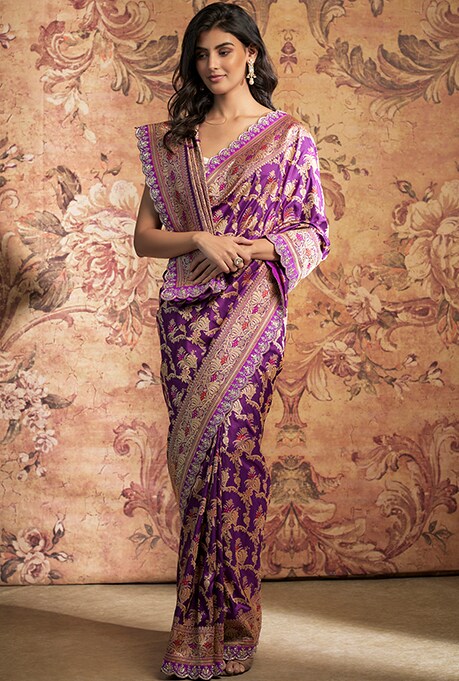In India, the saree is a canvas of cultural expression, an emblem of history, and a beloved art form. Nowhere is this truer than in Uttar Pradesh, where the saree carries a weight of history as heavy as the fabric itself. Within the folds lies an unbroken lineage connecting women from all walks of life to their heritage. Here, the traditional draping styles have not only been preserved but embraced, each fold and pleat imbued with stories that speak of the state’s vibrant identity.
A quick look at the history of Banarasi silk sarees tells this tale eloquently. With roots tracing back to the Mughal era, Banarasi sarees from Varanasi represent some of the most exquisite craftsmanship in the world. During the Mughal era, sarees became a staple of North Indian royal attire, capturing the attention of queens, princesses, and noblewomen. Each weave and pattern symbolised not only wealth but also a unique form of storytelling. Artisans took pride in weaving patterns symbolising prosperity, growth, and peace into their sarees, using motifs such as peacocks, flowers, and sacred temples. These motifs were woven into Banarasi silk sarees, their shimmer as alluring as the Ganges river flowing through Varanasi. The sarees were draped in a way that reflected grace and strength – a reflection of the women who wore them.
Over time, the saree style became known for its distinctive pleating, with a pallu that elegantly drapes over the shoulder, showcasing the artistry on the fabric’s border. The saree allowed women to express themselves while remaining in harmony with social norms, their identities woven seamlessly into the fabric.

Mastering the Drape: A Step-by-Step Guide
The saree draping process is an artful ritual, and the draping style unique to Uttar Pradesh adds an air of sophistication and elegance. Here’s a step-by-step guide to mastering this classic style:
- Tuck and Wrap: Begin by holding one end of the saree at the waist. Start tucking it in while wrapping the saree around your waist once, moving in an anti-clockwise direction. This forms the base of the saree drape, securing it neatly around the hips.
- Pleating the Front: Once wrapped around, gather the fabric to form pleats at the front, about 5-7 pleats, each around 4-5 inches wide. These pleats are then tucked into the waistband, ensuring they fall straight and gracefully down the front, a signature of the elegant look common in Uttar Pradesh.
- Draping the Pallu: After securing the pleats, the saree’s remaining length is draped over the left shoulder to form the pallu or loose end of the saree. This pallu can be left to flow freely over the shoulder or pinned to allow ease of movement.
- Pallu Pleats: In many parts of Uttar Pradesh, especially in traditional settings, the pallu is carefully pleated and pinned at the shoulder. This style allows the intricate designs along the saree’s border to take centre stage, showcasing the artisanal beauty of Banarasi sarees.
Finally, Banarasi sarees are generally accessorised with bangles, necklaces, or nath (nose ring) to complete the look. Women often wear flowers in their hair, such as jasmine, as the final touch to the look. In some regions, a waist belt, or kamarband, is added to keep the saree secure and add a layer of elegance.
The Evolution of Banarasi Sarees
Today, the saree has seen remarkable transformations while retaining its essential charm. Uttar Pradesh has taken the lead in not only preserving traditional draping styles but also inspiring modern adaptations. The classic Banarasi saree, once reserved for special occasions, is now a part of contemporary wardrobes, with some pairing it with Western accessories like jackets or belts for a bold yet traditional look.
Among younger women, there’s a rising trend of experimenting with new draping techniques. Some choose to wear the saree as a gown, draping it in a way that’s easier to handle, while others opt for a minimalist look by reducing pleats and using belts to create a sleeker silhouette. Bollywood, too, has played a role in this evolution, with actresses bringing traditional styles back into the limelight, encouraging more people to embrace sarees on an everyday basis.
Though styles may change, the draping technique of Uttar Pradesh sarees remains a timeless classic. In a world of ever-shifting trends, the Banarasi saree from Uttar Pradesh remains a steadfast symbol of elegance, identity, and culture. Whether it is a bride draped in red Banarasi silk on her wedding day or a young woman embracing it for a family function, the saree continues to hold its ground as a treasured symbol of beauty and tradition. It is an attire that will continue to inspire, adapt, and endure – an eternal garment as rich in meaning as it is in beauty. The saree is, and will always be, a celebrated testament to the artistry and heritage of Uttar Pradesh.

























































































































































